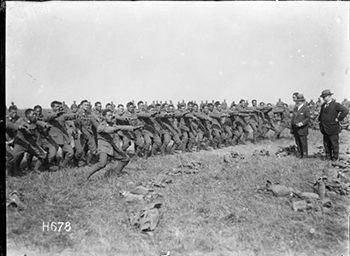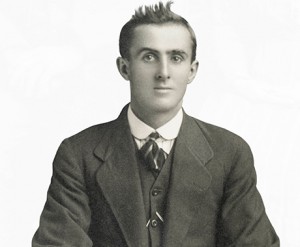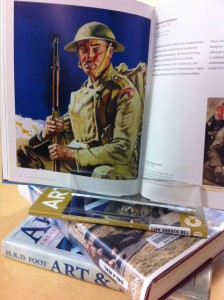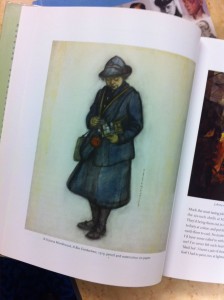
On Sunday 11 November the world commemorates 100 years since the signing of the armistice that ended the First World War in 1918. Over 100,000 New Zealanders served during the war and more than 18,000 were killed. This had a devastating affect on people at home and on November 11 1918 the armistice came as a huge relief that was met with joy and thankfulness. Armistice Day has since become a time to reflect on the losses of the war, the hopes of peace, and the contributions of all who served.
An often unknown part of New Zealand’s involvement in the First World War is the courageous participation of Māori, New Zealand Chinese, Cook Island Māori, Fijians, Niueans, Tongans, Samoans, Tuvaluans, and men from Kiribati and Norfolk Island. More than 2,200 Māori and around 500 Pasifika men served overseas with the New Zealand Forces. Just like other ANZAC soldiers these men left their homes, families, and cultures to go to the other side of the world and fight in what was hoped to be ‘the war to end all wars’. They frequently experienced racism, deprivation, and a lack of acknowledgement after the war of their valuable contribution. The story of Te Hokowhitu a Tu, the Māori Pioneer Battalion, is an important part of our First World War history and we have a good selection of items in our library that chronicle the Battalion and the involvement of soldiers from the Pacific.
To learn more, check out the display of books on the second floor at the Central Library and explore the titles and websites listed below: Maiea te tupua : whānau accounts of Waikato-Maniapoto World War One veterans and one conscriptee : commemorating 100 years of World War One / produced by Pūrekireki Marae with the support from Te Pua Wānanga ̄ki te Ao of the University of Waikato, the Waikato Raupatu Lands Trust, the Maniapotō Māori Trust Board, Trust Waikato and Te Puni Kōkiri. Le fitafita mai Samoa/The force from Samoa: soldiers from the Samoan Islands in the Great War / Christine Liava’a. Chinese Anzacs : Australians of Chinese descent in the defence forces 1885-1919 / by Alistair Kennedy. Websites: Te Puni Kōkiri: Kei Wareware Tātou, Lest We Forget Te Ara: Māori Contingent in the First World War New Zealand History: Māori in the NZEF Pioneer Battalion Te Papa: Were there Pacific Islanders at Gallipoli in 1915? Sunday 11 November 2018 Commemorations: Armistice Day 2018 will be marked with events throughout New Zealand including the live-streaming of the Armistice Centenary National Ceremony at Pukeahu National War Memorial Park in central Wellington. Check out this website for details: Armistice Centenary
 Te Hokowhitu a Tu : the Maori Pioneer Battalion in the First World War / Christopher Pugsley.
Te Hokowhitu a Tu : the Maori Pioneer Battalion in the First World War / Christopher Pugsley.
“Distinguished military historian Chris Pugsley recounts the story of the Māori Pioneer Battalion for a new generation. Drawing on rare archival material and previously unpublished diaries and letters, he tells not only the wider story of the the Battalion’s military exploits but also gives a vivid account of the daily life of the soldiers on active service. Illustrated with a large number of fascinating photographs, the book also includes a complete list of all those soldiers who fought with the Battalion.” (Adapted from book cover)
This beautifully illustrated book contains whānau accounts of Waikato-Maniapoto World War One veterans and one conscriptee. It was written by Tom Roa and Maehe Paki and gives moving personal accounts from family members. Maori in the great war / James Cowan.
Maori in the great war / James Cowan.
“In 1914 the population of New Zealand was little more than one million, of whom 50,000 were Maori. Eventually 2227 Maori men served overseas, the vast majority volunteers. 336 paid the supreme sacrifice, of whom 196 were killed in action or died of wounds. A further 734 were wounded, an over-all casualty rate approaching 50%. This revised; Maori in the Great War; contains appendices specifying full details of every soldier who served as well as the Roll of Honour.” (Adapted from Syndetics summary) Niue and the Great War / Margaret Pointer.
Niue and the Great War / Margaret Pointer.
“The story of tiny Niue’s involvement in the Great War has captivated people since an account was first published by Margaret Pointer in 2000. In 1915, 160 Niuean men joined the NZEF as part of the 3rd Māori Reinforcements and set sail to Auckland and then Egypt and France. Most had never left the island before, or worn shoes before. Most spoke no English. Most significantly, they had no immunity to European disease. Within three months of leaving New Zealand, over 80 per cent of them had been hospitalised.” (Adapted from book cover) Koe kau to’a na’anau poletau/Valiant volunteers: soldiers from Tonga in the Great War / Christine Liava’a.
Koe kau to’a na’anau poletau/Valiant volunteers: soldiers from Tonga in the Great War / Christine Liava’a.
“At the beginning of the Great War, 1914-1918, the British Empire rallied to Lord Kitchener’s call to arms. British men in Tonga, a protectorate of Britain, although never part of the Empire, heeded his call and enlisted in the Australian and New Zealand forces. Some Tongan men joined them. This book lists the names of these men with their military details, family information, awards, and their deaths. Many photographs are included. An overview of their service and a chronology of events are also given.” (Adapted from Syndetics summary)
“At the beginning of the Great War, 1914-1918, Western Samoa was invaded and captured by a New Zealand force acting on behalf of Britain. Australia similarly invaded and captured German New Guinea. Thus the German possessions in the South Pacific were rendered incapable of assisting in the German war effort. American Samoa remained neutral until 1917, when American men were registered as available for service, Volunteers from both Western and American Samoa enlisted in New Zealand, Australia, America and Britain. This book lists all the men from the islands of Samoa who served in these forces, with their military details, family information, awards, and deaths. Photographs of as many as possible are included. An overview of the situation and events in Samoa, a chronology, and several appendices are also given.” (Syndetics summary) Soldiers from the Pacific: the story of Pacific Island soldiers in the New Zealand Expeditionary Force in World War One / Howard Weddell ; edited and produced by Peter Cooke, Defence of NZ Study Group.
Soldiers from the Pacific: the story of Pacific Island soldiers in the New Zealand Expeditionary Force in World War One / Howard Weddell ; edited and produced by Peter Cooke, Defence of NZ Study Group.
“During World War One over 1,000 men from Cook Islands, Fiji, Niue, Tonga, Kiribati, Tuvalu, Samoa and Norfolk Island volunteered to join the New Zealand Military Forces. Their service included Gallipoli, France, Egypt and Palestine. Despite the fact that 107 of these men died of disease or enemy action, 73 were wounded in action and three became prisoners of war, regrettably their story has yet to be told. They served New Zealand and this is their story.” (Back cover)
Chinese ANZACs discusses the little known participation of Australian-born and New Zealand-born Chinese in the defence forces during the First World War. Includes a list of New Zealand-born Chinese in the NZEF 1915-1919.























